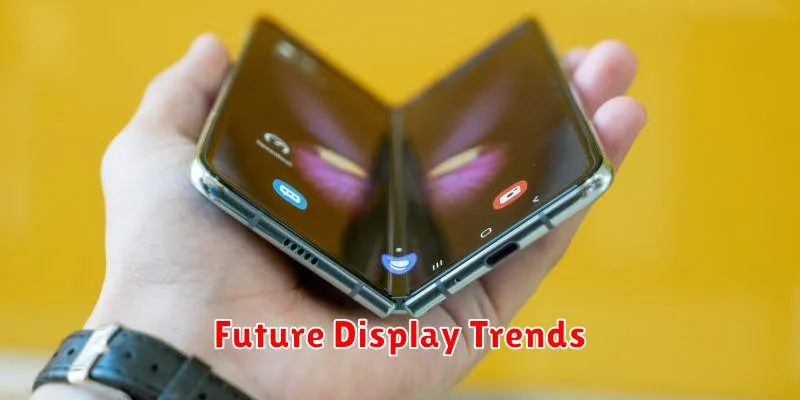In today’s digitally driven world, smartphones have become indispensable tools for communication, entertainment, and productivity. A crucial aspect of the smartphone experience, often overlooked, is display quality. The display is our primary interface with the device, influencing everything from browsing websites and watching videos to playing games and editing photos. Understanding why display quality matters can significantly impact your satisfaction with a smartphone purchase. Factors such as resolution, brightness, color accuracy, and contrast ratio play a vital role in shaping the overall user experience. This article delves into the critical reasons why prioritizing display quality is essential when choosing your next smartphone.
Investing in a smartphone with a high-quality display is an investment in a superior user experience. A good display enhances readability, reduces eye strain, and makes media consumption more enjoyable. Beyond the immediate benefits, a durable and well-designed display contributes to the longevity of the device. By exploring the technical specifications and understanding the impact of display quality, consumers can make informed decisions and select a smartphone that meets their specific needs and preferences. This article will equip you with the knowledge to discern the differences between various display technologies and make a choice that truly elevates your smartphone interaction.
Types of Displays: LCD vs. OLED
Two primary display technologies dominate the smartphone market: LCD (Liquid Crystal Display) and OLED (Organic Light Emitting Diode). Each offers distinct advantages and disadvantages.
LCDs rely on a backlight that shines through a layer of liquid crystals to produce images. They are generally more affordable to manufacture, but can suffer from lower contrast ratios and less vibrant colors compared to OLEDs. LCDs also tend to consume more power, especially when displaying brighter images.
OLEDs, on the other hand, utilize self-emitting pixels, meaning each pixel generates its own light. This allows for true blacks, as pixels can be completely turned off, resulting in infinite contrast ratios and superior color accuracy. OLEDs are also typically thinner and more flexible than LCDs.
Resolution: HD, Full HD, and Beyond
Resolution refers to the number of pixels that make up a display. Higher resolutions translate to sharper images, clearer text, and a more detailed viewing experience. This is particularly important for tasks like viewing high-resolution photos, watching videos, and playing graphically demanding games.
Common smartphone resolutions include HD (720p), Full HD (1080p), and Quad HD (1440p). HD offers a decent visual experience, while Full HD provides a significant jump in clarity. Quad HD and beyond deliver even sharper visuals, though the difference may be less noticeable to the average user. Choosing a higher resolution often impacts battery life, so consider your usage and needs.
Refresh Rate and User Experience

A refresh rate measures how many times per second a display refreshes the image. Measured in Hertz (Hz), a higher refresh rate directly translates to a smoother, more fluid visual experience. Standard displays typically operate at 60Hz, meaning the image refreshes 60 times per second.
However, many modern smartphones offer higher refresh rates, such as 90Hz, 120Hz, or even 144Hz. These higher rates dramatically improve the perceived smoothness, particularly noticeable when scrolling through content, playing games, or watching videos. The difference between 60Hz and 120Hz, for example, is a significantly more responsive and less blurry experience.
Brightness and Outdoor Visibility
Smartphone displays need to be easily visible in various lighting conditions, especially outdoors. Brightness plays a crucial role in this. A brighter display ensures content remains legible even under direct sunlight.
Peak brightness, measured in nits, is a key specification to consider. Higher nits typically translate to better outdoor visibility. Additionally, features like automatic brightness adjustment can dynamically optimize the screen’s brightness based on ambient light, improving both visibility and power efficiency.
Color Accuracy and Calibration
Color accuracy refers to how faithfully a display reproduces colors compared to real life. A color-accurate display shows colors as they are intended, without any unnatural tints or distortions. This is crucial for tasks like photo editing, graphic design, and even enjoying media where color plays a significant role.
Calibration is the process of adjusting a display’s color output to ensure accuracy. Some smartphones offer built-in calibration tools, allowing users to fine-tune the display to their preferences or a specific color standard. A well-calibrated display ensures a consistent and reliable visual experience.
Displays with poor color accuracy can make images look washed out, oversaturated, or simply incorrect. This can negatively impact the user experience, especially for professionals who rely on accurate color representation.
Display Protection: Gorilla Glass and Others
A smartphone’s display is constantly exposed to potential damage from drops, scratches, and everyday wear and tear. Protecting this vital component is crucial. Gorilla Glass, developed by Corning, has become a leading standard in display protection. Its specialized alkali-aluminosilicate glass composition provides enhanced damage resistance, helping to prevent scratches and cracks.
Beyond Gorilla Glass, other manufacturers offer competing solutions like Dragontrail and Sapphire glass. These alternatives also provide varying degrees of scratch and impact resistance, contributing to the overall durability of the device. Choosing a smartphone with robust display protection ensures longevity and maintains the screen’s clarity for an optimal viewing experience.
Curved Screens vs Flat Displays
A key differentiator in smartphone displays is the curvature of the screen. While flat displays remain the standard, curved screens have gained popularity, offering a distinct aesthetic and purported advantages.
Curved displays are touted for their immersive viewing experience, minimizing reflections and offering a wider apparent field of view. However, they can be prone to accidental touches and may distort images at the edges. Furthermore, they often come with a higher price tag.
Flat displays, on the other hand, offer better usability for everyday tasks, along with greater durability and affordability. They provide a consistent image across the entire screen, free from the distortions that can plague curved displays.
Ultimately, the choice between a curved or flat display depends on individual preferences and priorities.
Touch Sensitivity and Responsiveness
Touch sensitivity and responsiveness are crucial aspects of display quality, directly impacting user experience. A highly sensitive screen accurately registers even the lightest touches, minimizing the need for repeated taps or excessive pressure. This contributes to a more fluid and intuitive interaction with the device.
Responsiveness refers to how quickly the display reacts to touch input. Low latency ensures that actions like scrolling and gaming feel smooth and natural, free from frustrating delays. A responsive display contributes significantly to the overall perception of a phone’s performance and premium feel.
Factors influencing touch performance include the quality of the digitizer, the software processing the input, and the display panel itself. These elements work together to determine how accurately and quickly your touch translates into on-screen actions.
Notch vs Punch-Hole vs Under Display Camera
Smartphone displays have evolved to maximize screen real estate. Three prominent solutions for housing the front-facing camera are the notch, punch-hole, and under-display camera. Each presents its own trade-offs.
The notch, popularized by the iPhone X, houses the camera and sensors in a cutout at the top of the display. While intrusive, it allows for more sophisticated sensor arrays. The punch-hole is a smaller circular cutout, typically located in the corner, minimizing disruption. Lastly, the under-display camera (UDC) hides the camera beneath the screen, achieving a truly uninterrupted display, although often at the cost of image quality.
Choosing the right display technology depends on individual priorities. If maximizing screen real estate is paramount, the UDC is the clear winner. If image quality from the front-facing camera is critical, the notch or punch-hole might be preferred.
Future Display Trends

The future of smartphone displays promises further advancements in several key areas. Foldable and rollable displays are gaining traction, offering flexible form factors and expanded screen real estate. These technologies will continue to mature, becoming more durable and affordable.
Higher refresh rates beyond the current 120Hz standard are also anticipated, leading to even smoother animations and improved responsiveness. Improved color accuracy and brightness will enhance visual experiences, making displays more vibrant and realistic.
Finally, advancements in under-display camera technology will lead to truly bezel-less designs, maximizing the screen-to-body ratio. These combined advancements will push the boundaries of what’s possible with smartphone displays.

